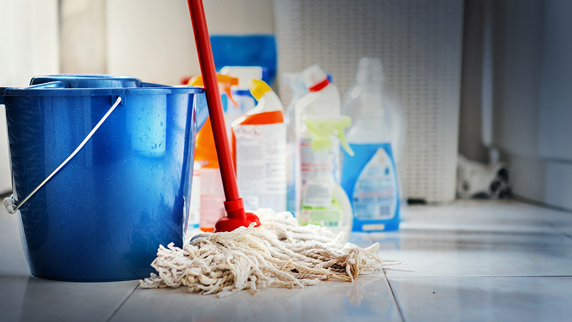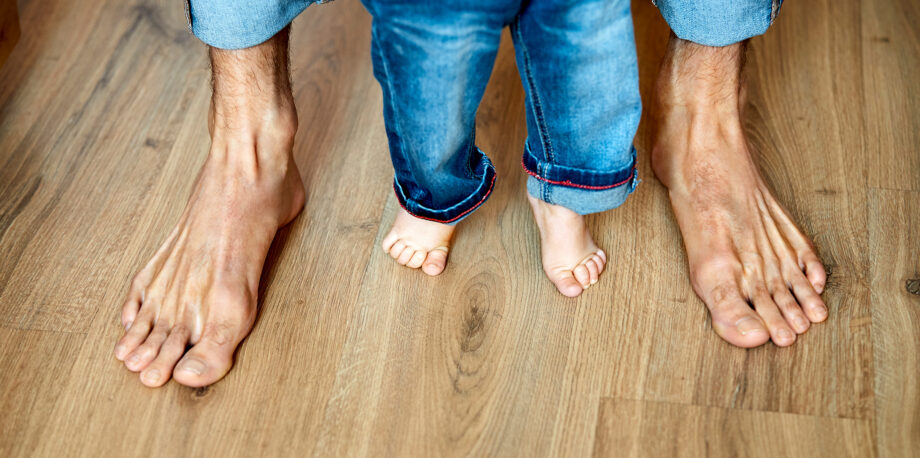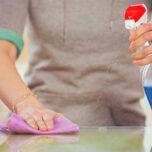May 5, 2020 — When you buy a pair of blue jeans, you probably don’t think about the harm they might cause to people or the environment. But synthetic dyes and other chemicals used to manufacture jeans and other clothing can make workers sick and pollute waterways, particularly in manufacturing regions in Asia, where heavy metals like cadmium, chromium and lead have been found in water and sediment outside of textile industrial parks.
Now that’s starting to change, as organization and consumer demand for products that don’t harm people or pollute the environment move forward-thinking brands toward safer chemistry. Levi’s, for example, discontinued the use of a water repellent–containing short-chained perfluorinated chemicals, or PFAS, the “forever chemicals” that are linked to cancer, associated with reproductive harms and turning up in drinking water everywhere. The company switched to a safer, PFAS-free chemical formulation with the help of GreenScreen, a hazard assessment scheme that rates chemicals’ risk of harm to human health and the environment, including their ability to persist and bioaccumulate in nature, among other criteria. GreenScreen helps companies avoid swapping out one toxic chemical for another.
U.S. regulations have allowed tens of thousands of chemicals that environmental advocates say are inadequately tested for potential hazard to make their way into products, from clothing to toys to food packaging to the building materials in our homes. To close the gap, a handful of nongovernmental organization–led hazard assessments like GreenScreen have emerged in the past 10 years to guide manufacturers toward more sustainable chemistry.
They exemplify the type of progress that’s been made in the two decades since chemists and inventors Paul Anastas and John Warner first defined principles for green chemistry, an approach to designing chemicals and materials that are safe for human health and the environment. Collaborations between NGOs and big brands like Google, Walmart and Target — such as the Green Chemistry & Commerce Council (GC3) and ChemFORWARD — are moving companies toward safer chemistry and signaling to chemical manufacturers that they need to get on board. What’s lagging, however, is development of alternative chemicals and regulations that would hasten the transition.
From Green to Sustainable
Green chemistry is a strategy for preventing harm by designing chemicals and materials that are safe for people and ecosystems. Its principles include efficient use of resources; elimination of toxic ingredients, harmful waste and hazardous byproducts; and energy efficiency throughout a product’s entire life cycle.
Sustainable chemistry embraces green chemistry principles and adds in elements to support commercialization and circularity.As it moves into commerce, companies and some NGOs are calling it sustainable chemistry, because it “pings on all the right notes for the C-suite and [other] decision makers,” says Michele Jalbert, co-director of GC3, a collaboration of 120 organizations, including green chemistry startups, retail giants and government agencies focused on accelerating the application of green chemistry in manufacturing. Sustainable chemistry embraces green chemistry principles and adds in elements to support commercialization and circularity, she says.
“I don’t think anything can be accomplished without safer, better chemistry because it’s in everything that we touch,” says Jalbert.
Disclosure Drives Action
To make products better for human health and the environment, you have to know what your suppliers are using to make what they send your way. But “20 years ago, most companies didn’t have a clue about what was in their products … unless there was a legal requirement,” says Mark Rossi, executive director of Clean Production Action and co-author of GreenScreen.
Chemical formulations are often proprietary, which is part of why companies might not know what’s in their supply chains. Still, “the idea that you would disclose the chemistry in products was heavily resisted,” says Rossi.
In recent years, however, manufacturing has seen what Rossi calls “a sea change in transparency.”
Levi’s, for example, relies on hundreds of suppliers to produce its jeans. Mills spin cotton into yarn, dye it and apply various coatings, such as water repellents. Other vendors cut and sew the jeans, and laundries apply chemicals that give the jeans their look and feel.
In the past Levi’s left the choice of dyes and finishing products up to the mills and laundries in its supply chain, as long as they adhered to existing regulations and company policy. But then Greenpeace’s 2011 Detox My Fashion Campaign pushed the company to clean up the pollution in its supply chains by committing to zero discharge of hazardous chemicals (ZDHC) by 2020 and discontinuing use of certain chemicals.
Levi’s hired a toxicology firm to help it detect formulations its suppliers were using that could contain chemicals of concern, following criteria from GreenScreen and EPA’s Safer Choice, a hazard screen for cleaning products. In a pilot initiative, it asked three suppliers to provide their proprietary formulation details to the toxicology firm, which then worked with the two hazard screens to determine human health and environmental toxicity scores. By 2015, the company had screened 132 chemicals and found 17 to be hazardous or no-go chemicals.
“We never had this visibility before,” said Linda Gallegos, Levi’s senior design innovation lead, in a University of California, Berkeley, case study.
Levi’s reported in 2016 it had found cost-neutral substitutes for three of the problem chemicals and laid out goals for implementing a program for screening chemicals more broadly across its supply chain. The company did not respond to a request for an update on its progress.
Costs and Time
A big challenge for moving forward is finding suitable substitutes. “Over the last decade we’ve done a great job at creating the demand,” says Warner, who is president and chief technology officer with the Warner Babcock Institute for Green Chemistry. “There’s no doubt in my mind that consumers prefer a technology that’s green — that a brand, a retailer, a manufacturer all prefer green technology. What people don’t fully appreciate is that the technologies don’t exist.”

As consumers advocate for safer ingredients, companies are reformulating cleaning supplies and other products to reflect green chemistry principles. Photos © iStockphoto.com/gilaxia
Warner estimates that about 65% of chemicals used in manufacturing today do not have a safer alternative. About 10% of chemicals used in products are not hazardous, he says, while alternatives can be found for another 20% to 25%.
Levi’s experience exemplifies the costs and time involved in swapping out chemicals. “If I’m a company,” says Joel Tickner, professor at the Lowell Center for Sustainable Production at the University of Massachusetts, “first I have to pay for the chemistry, which might be more expensive, then I have to go back to my product and reformulate it, which might cost millions of dollars, to get the same performance.”
Martin Wolf, director of product sustainability and authenticity for Seventh Generation, a B corporation that manufactures plant-based home products, says that after learning that borax could cause reproductive harm, it took his company two years to work with its supply chain, perfect a new product without borax, and get it onto store shelves.
Where’s the Progress?
Focusing on the intrinsic hazards of chemicals has led to the proliferation of restricted substances lists like ZDHC’s Manufacturing Restricted Substances List, as well as hazard screens that assign chemicals a low (green), medium (yellow) or high (red) score like GreenScreen, Cradle to Cradle and ChemFORWARD.
Progress over the past decade has primarily involved companies moving from red chemicals to yellow or green chemicals — if they exist. In other words, companies are tangibly decreasing the hazards of products, but not necessarily retooling chemistry and materials.
Warner, however, says his institute for green chemistry, has developed 280 patents, licensed more than 100 technologies and spun out some half dozen companies making wholly new materials and chemicals These include Hairprint for safer hair dyes and Collaborative Aggregates for alternative asphalt. The institute also created the Adidas ocean plastic shoe.
Still, “it’s hard to jump from an existing chemical to a green, meets-all-principles chemical,” says Jalbert. “It could be an iterative process, [to] make them less toxic over time.
Sectors that have seen the most progress include apparel, personal care and cleaning products, toys, electronics, and construction, according to Rossi.

Personal care products are among the many consumer goods that are moving toward safer, more sustainable ingredients. Photo © iStockphoto.com | NARONGRIT
Nneka Leiba, vice president for healthy living science at Environmental Working Group (EWG), says she’s seen “monumental changes in the last five years” in the personal care sector. “Companies have avoided some ingredients, some of the worst ones, like paraben, phthalates and formaldehyde,” she says, adding that “they may still have other ingredients of concern.”
EWG’s Skin Deep hazard assessment tool, which rates 85,000 beauty and personal care products on a scale of 1 to 10 based on the toxicity of their ingredients, gets 1,000 online visitors per hour, Leiba says. Its EWG VERIFIED seal goes a step further by requiring manufacturers to submit their product formulations for certification by a toxicologist.
“We’ve seen not only brands moving, but more retailers creating aisles they’re calling clean or safe — showing that their consumers are definitely asking for this,” she adds. Target, for example, is rolling out an icon system to help consumers select products adhering to its lists of restricted chemicals, and Sephora is working with ChemFORWARD to identify safer alternatives to five categories of chemicals, according to Stacy Glass, executive director of ChemFORWARD.
Meanwhile, Seventh Generation, which Wolf says at its founding in 1988 committed to not using any chemicals that are known to cause cancer, mutations or reproductive harm, is not the only company producing green cleaners. Method and Mrs. Meyers are other such firms, now both owned by SC Johnson. P&G’s Pure line has “mimicked some of our formulas from 10 years ago,” says Wolf. SC Johnson has “a methodology for evaluating the greenness of an ingredient and annual incentives to improve that,” he adds.
Investing in Innovation
Warner says he’d like to see more focus on inventing new chemicals. He likens the emphasis on hazard screens to the lawn game where people toss bean bags through holes in a board. As he sees it, the board is a chemical screen and the bean bags are the chemicals that have to make it through the holes to be considered safer — only no one has a bean bag to toss but people are still cheering at the mere presence of the holes.
While Levi’s has removed hazardous substances used in process washes and as finishing agents, he says, it has yet to eliminate some dyes because good alternatives don’t exist. He’d like to see the company investing more in creating safer materials.
Wolf says that going green adds costs, but “you can create a business model that can tolerate a slightly higher cost of manufacturing, and make it up in other places.”“To retool a product line there is a small increment in price,” he says. “Brands have to be willing to accept that price increase to make this work. Invention comes at a cost.”
Wolf says that going green adds costs, but “you can create a business model that can tolerate a slightly higher cost of manufacturing, and make it up in other places. You can have a slightly less fancy package, or change the way you market the product. A company has many levers it can pull … or [it can] accept a slightly less margin.”
Tickner agrees. He says GC3 is working with eight midsize chemical companies that have “better solutions,” but are facing a supply chain that isn’t willing to absorb the costs of them.
“Walmart wants it sustainable, but they want it cheap too,” he says. “When you’re talking a new chemistry, you might have to build new manufacturing capacity for that chemistry, you’re talking a minimum of $100 million investment. Where is that money coming from?”
Warner says inventors could more easily attract investors if stakeholders could agree on a set of tests to determine toxicity and better define what’s safe.
“How can I convince someone to pay me to invent something if all I’ve been told is it can’t have BPA in it?” he asks. “The perception is anyone who comes to market with something new, they’re like Moby Dick, every toxicologist wants to be the one to reveal that what they just did is just as bad.” In other words, because chemical manufacturers have often replaced known toxic chemicals with slightly different versions that turn out to be just as toxic, as was the case with BPA or bisphenol A, Warner finds that investors are skittish about financing chemical alternatives out of fear that they’ll fail or become controversial.
The Sustainable Chemistry Research and Development Act (S. 999 and H.R. 2051), a bill championed by GC3 that passed the U.S. House of Representatives and made it out of the Senate Commerce Committee last year, would help incentivize investment by signaling to investors that green chemistry is a priority for the federal government, says Tickner.
Ultimately massive investment and regulations are what’s needed to shift to wholly new chemicals and materials, he says.
“Yes, we’ve made huge progress, and yes we have a long way to go,” he continues. “Until we elevate this as a systems level challenge, with big changes required, we’re never getting to scale. There has to be an urgency.”
05.21.2020 UPDATE: In a 2020 update, Levi Strauss & Co. reports that it has screened chemicals from roughly 100 suppliers and identified nearly 1,000 chemicals that are safer to use. These chemicals are on its preferred, safer chemical list, which the company asks 120 of its key garment and fabric suppliers and 200 chemical suppliers to use. Additionally, the company has banned the use in its products of the 11 priority chemical classes identified by Greenpeace’s 2011 Detox campaign, plus an additional 7 classes of similarly hazardous chemical classes banned in the Zero Discharge of Hazardous Chemicals Foundation’s Manufacturing Restricted Substances list (ZDHC MRSL). It also has banned the use of PFAS. Levi Strauss & Co. also open-sourced its Screened Chemistry program to ZDHC, and the industry and worked with several peer companies to create a single industry standard for chemical screening and guidance for third-party chemical hazard assessments.
Related Posts
Ensia shares solutions-focused stories free of charge through our online magazine and partner media. That means audiences around the world have ready access to stories that can — and do — help them shape a better future. If you value our work, please show your support today.
Yes, I'll support Ensia!




